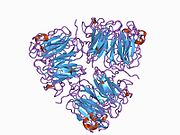
Ran also known as GTP-binding nuclear protein Ran is a protein that in humans is encoded by the RAN gene. Ran is a small 25 kDa protein that is involved in transport into and out of the cell nucleus during interphase and also involved in mitosis. It is a member of the Ras superfamily.

Guanine nucleotide exchange factors (GEFs) are proteins or protein domains that activate monomeric GTPases by stimulating the release of guanosine diphosphate (GDP) to allow binding of guanosine triphosphate (GTP). A variety of unrelated structural domains have been shown to exhibit guanine nucleotide exchange activity. Some GEFs can activate multiple GTPases while others are specific to a single GTPase.

RAN binding protein 2 (RANBP2) is protein which in humans is encoded by the RANBP2 gene. It is also known as nucleoporin 358 (Nup358) since it is a member nucleoporin family that makes up the nuclear pore complex. RanBP2 has a mass of 358 kDa.

G1/S-specific cyclin-E1 is a protein that in humans is encoded by the CCNE1 gene.

Interleukin enhancer-binding factor 3 is a protein that in humans is encoded by the ILF3 gene.
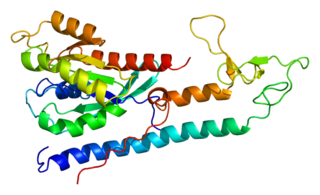
Ras-related protein Rab-3A is a protein that in humans is encoded by the RAB3A gene. It is involved in calcium-triggered exocytosis in neurons.

Rho guanine nucleotide exchange factor TIAM1 is a protein that in humans is encoded by the TIAM1 gene.

Rap guanine nucleotide exchange factor 3 also known as exchange factor directly activated by cAMP 1 (EPAC1) or cAMP-regulated guanine nucleotide exchange factor I (cAMP-GEFI) is a protein that in humans is encoded by the RAPGEF3 gene.

Ran GTPase-activating protein 1 is an enzyme that in humans is encoded by the RANGAP1 gene.

Dock180, also known as DOCK1, is a large protein involved in intracellular signalling networks. It is the mammalian ortholog of the C. elegans protein CED-5 and belongs to the DOCK family of Guanine nucleotide exchange factors (GEFs).

Rho guanine nucleotide exchange factor 1 is a protein that in humans is encoded by the ARHGEF1 gene. This protein is also called RhoGEF1 or p115-RhoGEF.

RhoG is a small monomeric GTP-binding protein, and is an important component of many intracellular signalling pathways. It is a member of the Rac subfamily of the Rho family of small G proteins and is encoded by the gene RHOG.

Ran-specific binding protein 1 is an enzyme that in humans is encoded by the RANBP1 gene.
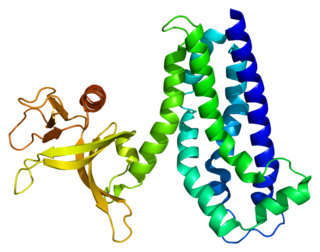
Triple functional domain protein is a protein that in humans is encoded by the TRIO gene.
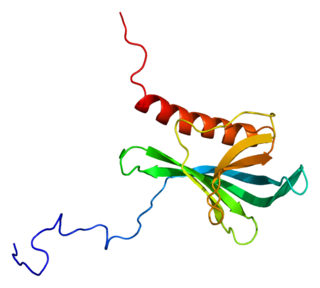
Ran-binding protein 3 is a protein that in humans is encoded by the RANBP3 gene.
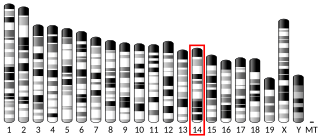
RCC1 and BTB domain-containing protein 1 is a protein that in humans is encoded by the RCBTB1 gene.

Rap guanine nucleotide exchange factor 5 is a protein that in humans is encoded by the RAPGEF5 gene.

Guanine nucleotide-binding protein subunit alpha-12 is a protein that in humans is encoded by the GNA12 gene.

RCC1 and BTB domain-containing protein 2 is a protein that in humans is encoded by the RCBTB2 gene.

Mary C. Dasso is an American biochemist known for research on chromosome segregation and the discovery of Ran GTPase. She is the acting scientific director of the division of intramural research and a senior investigator in the section on cell cycle regulation at the Eunice Kennedy Shriver National Institute of Child Health and Human Development.

























